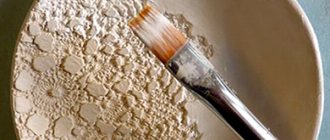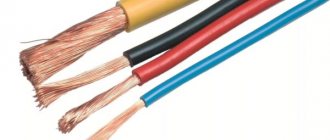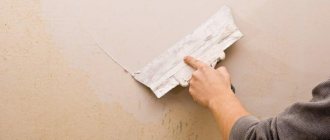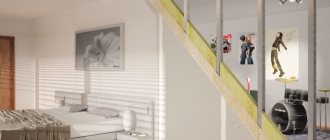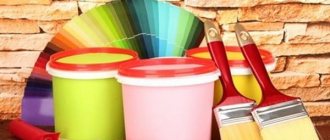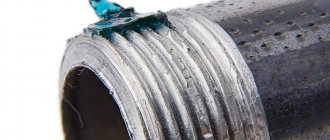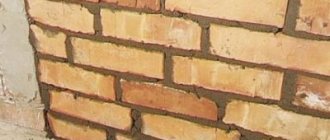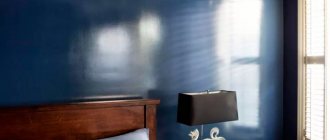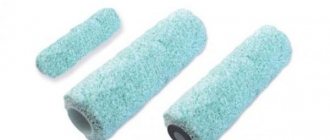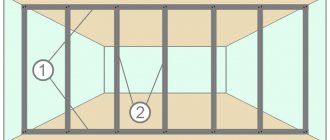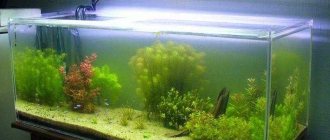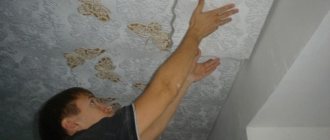Wood is a special building material; it is highly environmentally friendly; walls made of logs and timber last a long time, providing good thermal protection. But wood is a living material, susceptible to rot, mold, and pests, so it is important to take care of its additional protection.
The simplest protection option is painting, but it is associated with a number of difficulties. How to paint a log house in such a way as to protect the wood as much as possible, and at the same time keep the environmental friendliness of the house at the same level?
The need to paint a wooden house inside
Painting wood protects it from moisture, dirt and mold.
Wood is a porous material. This feature is an advantage and a disadvantage. Wood absorbs excess moisture from the air inside the room and removes it outside, so it is never stuffy or humid in a log house. However, with high humidity, the tree is no longer able to remove it. Then the walls and floors in the building become deformed, become moldy, and rot.
Painting the timber inside and outside the house protects the material. The paint forms a thin waterproof film on the surface. In this case, moisture no longer gets inside the tree. This is not the only advantage of painting:
- Paint is an extremely diverse finishing material. They produce shiny and matte compositions, transparent and with a high level of coverage, textured and smooth. The richness of shades is enormous.
- Painting takes minimal time and is one of the fastest finishing methods.
- Coloring is a simple job. Even a beginner can completely change the design of a room with paint coatings.
- Compositions with high density and texture hide minor irregularities and defects.
- Painting logs inside the house protects the wood not only from moisture. The composition prevents the development of fungi and mold infection, since most of them have an antiseptic effect.
- The polymer layer protects the tree from bark beetles and other harmful insects.
- Paints, even the most expensive ones, cost much less than finishing with clapboard or plaster.
When choosing a coloring composition, take into account the purpose of a specific room. Smooth coatings are preferable for bathrooms and kitchens, as they do not accumulate dirt and are easier to care for.
General recommendations
How to paint a wooden house from the inside? Every homeowner has asked this question at least once in their life. Painting a log house is not an easy task. Many owners, doing this themselves, skip the preparatory stage and immediately proceed to painting.
Because of this error, various troubles with painted surfaces are possible, for example, wood rotting and the appearance of parasites in it. You need to paint the wood according to the above description. Therefore, painting timber and timber houses will take a lot of time and effort.
Paint for the interior decoration of a wooden house must be environmentally friendly, dry quickly and have no odor. The decorative finishing of a room, as well as its design, directly depends on the correct choice of this material. When choosing paint, carefully study the labels and consult with store clerks.
Painting tips (1 video)
Different types of paints and varnishes (31 photos)
Rules for choosing paint
Oil paint completely hides the pattern on the wood.
Paint for wooden walls inside the house should not only be practical and beautiful, but also safe. Indoors it is allowed to use compounds that, during drying and further use, do not emit harmful substances, strong odors, etc.
For interior decoration, water-based and organic paints are used. The former are not always resistant to water. Some of them can be washed off with water. Organic solvent compositions usually have a higher degree of coverage, water resistance and durability. However, you need to choose them with caution: not all solvents are safe for humans and pets.
Oily
A type of coating on an organic basis - drying oil. The thinner is white alcohol, turpentine, gasoline. The cost is low, the hiding power is high: the wood grain becomes invisible. Oil paints adhere well and, due to the large thickness of the layer, mask minor surface defects. This coating is not afraid of moisture; it can be washed with plain and soapy water.
Among the disadvantages, it is worth mentioning the long drying time and the strong smell due to the solvent. During drying, the composition releases harmful substances, so you should not enter the painted room for several days.
Oil paints are often used for exterior decoration. However, they are often used for painting kitchens and bathrooms, where high resistance to water is important.
Acrylic
Most often, acrylic paints are chosen for interior work, as they are the safest.
A type of water-dispersion paint. The solvent is ordinary water, which makes the composition safe. The coloring matter, polyacrylates, is introduced into the mixture in the form of a dispersion, not an emulsion. This feature provides higher resistance to water compared to water emulsion: the acrylic coating is not washed off the walls and can withstand repeated wet cleaning.
Acrylic paints can be diluted with water to make the shade less intense, and aqueous pigment pastes can be added to the solution to obtain a different color. This significantly increases the color gamut.
Acrylic paint becomes darker as it dries.
Alkyd and enamels
Alkyd paints are best used for exterior house painting, as they take longer to dry.
Paints and enamels of this kind are based on alkyd resin. When dried, the substance forms a very dense, smooth, even surface, so most enamels are glossy or shiny. The paint completely hides the pattern and color of the wood. Enamels are used for interior and exterior decoration, since the finished coating is completely resistant to water and aggressive household chemicals.
The composition is very durable and dries quickly. However, the solvent for it has a strong unpleasant odor, which does not disappear until it dries completely. Although not all compounds emit toxins, work can only be performed in a respirator.
When choosing, you need to pay attention to the composition of the paint and its purpose. Not all options are suitable for painting wooden or log walls inside the house.
Water-dispersed
The base of the composition is water. Coloring pigments and fillers are in the form of a dispersion. A common feature of such paints is resistance to water and steam.
Water-dispersed ones include polyvinyl acetate, latex and acrylic. The former are used only indoors with low humidity, as they are not resistant to water. The latex composition can be used in the bathroom and in the pool, as it withstands the influence of steam well. Acrylic paint is an option for wood inside and outside the house.
Silicone
Silicone paints are used for facade work.
For painting the inside of a wooden house, a mixture based on silicone resin seems to be one of the best options. With high water resistance, the coating allows air to pass through, which retains all the advantages of a wooden building. The paint does not fade in the sun, is completely insensitive to mold and fungi, and does not wear off.
Silicone mixture is one of the most elastic coatings. The finishing layer masks cracks up to 2 mm wide. The composition can be pigmented, changing the shade and intensity.
Silicone paints are only matte.
Advice from the experts
Experts answer frequently asked questions:
- What paint should I paint the floors with? It is a common belief that waterborne compounds are not suitable for painting floors, but this is not true. The acrylic layer is highly water-resistant and wear-resistant. This coating is applied to floors in interior spaces and on the veranda; you can paint the porch.
- Is it possible to paint wood with acrylic paint on metal? Acrylic paint for metal is less elastic, does not contain additives that protect wood, the paint can be used to paint a separate wooden part, the use of such paints for painting a log house is not practical.
- Is it possible to paint with color without paint? Color for acrylic paint is easily dissolved in water, such a solution has good coloring properties and is easily absorbed when applied to wood. The solution can be used to paint individual areas, but over a large area it will not be possible to achieve a uniform color: the sapwood, heartwood and knot locations will absorb water differently, and the color will be pockmarked.
- Is it possible to paint with acrylic paint over varnish? Water-dispersed compositions have high adhesion and adhere well to any surface, including surfaces treated with nitro varnish, parquet, acrylic and oil varnish.
Choosing paint according to purpose
Paint for a living space is not always suitable for a kitchen. To figure out which option is right, you need to pay attention to the digital code in the labeling. Its first numbers indicate the special properties of the paint:
- 1 – weatherproof;
- 2 – intended for interior work only;
- 3 – used for metal structures, not suitable for lining or timber;
- 4 – resistant to hot water and steam, it is chosen for the bathroom and kitchen;
- 5 – special, for example, for leather;
- 6 – resistant to oil products and fats, rarely used in everyday life;
- 7 – insensitive to aggressive environments;
- 8 – withstands high temperatures, suitable for the kitchen;
- 9 – has electrical insulating properties;
- 0 – these are primers and enamels;
- 00 – putties.
Compositions that are resistant to steam or oil are more expensive than conventional ones. So you should buy them only for finishing special rooms.
How to paint a log house with Biocolor Ultra
Before use, the product only needs to be mixed; there is no need to dilute it with anything. You can use a brush, roller or spray gun to apply Biocolor Ultra. But for applying paint with a spray device, it can be diluted with white spirit. Before painting, it is recommended to treat the surface with antiseptic compounds, and if the log house has already been affected by mold, then you need to get rid of colored stains using a special bleach. It is recommended to paint the log house in several layers. Please note that the paint is flammable, so smoking while working and lighting a fire nearby is prohibited. The surface dries completely after 24 hours. Paint consumption depends on the properties and condition of the log house.
Required tools and materials
Brushes are used to paint small parts.
Before painting the log house or panels inside the house, you need to stock up on some tools and auxiliary materials:
- brushes and rollers, as well as trays for them;
- sprayer, if you decide not to paint the walls manually;
- masking tape – used to cover surfaces that should not be painted;
- rubber gloves, protective clothing, in some cases a respirator or protective mask will be required;
- wet rag, sponge or bucket.
Films are also needed to protect the floor, plumbing fixtures or furniture that cannot be removed from the room.
Preparatory work
Before painting, remove the old coating and sand the boards.
Painting the inside of a house begins with preparing the surfaces. A wooden wall, by its nature, remains porous. In order for the paint to lay evenly on it, the following is required:
- The walls are cleaned of dust and dirt.
- Remove the old finishing layer, if any. The paint is washed off or removed using a sanding machine.
- They inspect the walls. If mold or rotten spots are found on the wood, these places are cleaned with a wire brush. Then the areas are treated with antiseptic impregnations or primers to protect the wood from fungi and mold. Boards that are more than half rotten are replaced with new ones.
- Nail heads and remnants of other fasteners are removed.
- Fallen knots, cracks, and gaps are filled with plaster mixtures with sawdust. After drying, the areas are smoothed with sandpaper.
- Before painting wooden walls inside and outside the house, the surface is impregnated with a primer. This composition improves the degree of adhesion of paint to wood.
Other measures may be necessary, for example, leveling or sanding walls, additional treatment with antiseptics or bleaches.
Do-it-yourself painting of a wooden house inside
For a long-term effect, it is necessary to apply 2 - 3 layers of paint.
Algorithm for basic work:
- If the walls or floor are made of highly porous, soft wood, such as pine, the surfaces should be primed twice. The top layer of such wood absorbs the liquid composition like a sponge. If you immediately paint a pine or apple tree with paint, the latter is absorbed and you have to apply an additional layer.
- After the primer layer has completely dried, the first coat of paint is applied. Brushes or rollers are used. To paint a large, flat area, take a spray gun.
- Cover the wall with 2-3 layers of paint to achieve a good effect. Each subsequent layer is applied when the previous one is completely dry.
- If necessary, painted walls can be further decorated. To add shine, cover the surface with a shiny varnish. To create the effect of antiquity, paints of several similar shades are used.
Painting wooden walls and floors is a quick and practical finishing method. The paint layer protects the material, prevents the appearance of mold or fungi and gives a new look to the interior.
What should be the means for painting a log house?
Coloring agents for log houses must have the following properties:
- Environmental friendliness. This is the most important property. After all, its residents have constant contact with the log house, and inhaling chemical vapors is very harmful to the health of people and animals.
- Attractive type of coating. Such a surface will be fully provided by acrylic, oil compositions or varnishes.
- Fire protection. Fire is the main and dangerous enemy of a log house. Therefore, it is advisable to purchase paints containing fire retardants.
- Protection from insects and biodestroyers. This property is not required for paint, but still desirable. And there are many coloring products on the market with such protective properties. They will prevent the appearance of mold, fungi and form a protective coating against insect pests.
In the markets, even knowing all the rules for choosing paint for a log house, making the right choice will not be easy. Even the price of a product will not help you distinguish the quality of a product. Nowadays, expensive material does not always have excellent characteristics. Therefore, you need to trust and purchase only proven and well-known brands, such as Neomid. They produce various coloring agents for painting any wooden materials and structures made from them. They can also choose an effective means for painting a log house. It is better to use two types of paints. Some with more effective and protective properties should be chosen for external painting, because... there will be more negative impacts on the surface (rain, sun, snow, frost, wind, etc.). And for painting outside, the requirements for paint properties can be set to minimum, the main thing is that they be environmentally friendly. From the Neomid company these are Biocolor Ultra and Biocolor Aqua.
